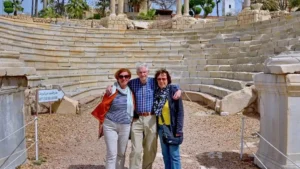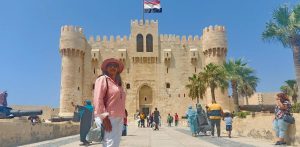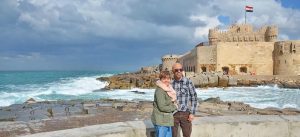Qaitbay Fort: Citadel of Qaitbay in Alexandria: A Historical Marvel
The Citadel of Qaitbay, also known as Qaitbay Fort, is a 15th-century defensive fortress located on the Mediterranean coast in Alexandria, Egypt. This iconic structure stands as a testament to the architectural ingenuity and strategic military planning of the Mamluk Sultanate. Built on the ruins of the ancient Lighthouse of Alexandria, one of the Seven Wonders of the Ancient World, the Citadel of Qaitbay is a significant historical and cultural landmark.

Historical Background
Sultan Al-Ashraf Sayf al-Din Qaitbay built Qaitbay Fort between 1477 and 1479 AD. Initially, the fortress primarily defended Alexandria. It protected against the advancing Ottoman Empire, which posed a significant threat at that time. Interestingly, builders chose the exact site of the ancient Pharos Lighthouse for the citadel, as earthquakes had destroyed the lighthouse by the 14th century.
Architectural Features
Furthermore, Qaitbay Fort is renowned for its robust and strategic design. Specifically, it sits on the eastern side of Pharos Island’s northern tip, extending into Alexandria’s harbor from the corniche. Builders employed the Mamluk architectural style, which incorporates Islamic, Ottoman, and Mamluk designs. Consequently, these elements give it a unique and striking appearance. The citadel’s main tower, for instance, is square-shaped, consists of three floors, stands 30 meters high, and measures 17 meters on each side.

Qaitbay Fort Strategic Importance
The Qaitbay Fort played a crucial role in the defense of Alexandria and the broader Mediterranean region. It was part of a network of coastal fortifications to protect Egypt from naval invasions. The fortress was equipped with various defensive features, including arrow slits, oil drops, observation rooms, and weapon storage areas. During the Ottoman period, the citadel continued to serve as a vital stronghold, safeguarding the northern coasts of Egypt.

Restoration and Modern Use of Qaytbay fort
Over the centuries, the Citadel of Qaitbay has undergone several periods of restoration and renovation. The Egyptian Antiquities Organization carried out the most significant restoration work in 1984. The British heavily damaged the fortress during their bombardment of Alexandria in 1882. Workers subsequently rebuilt it around the turn of the 20th century. Today, the citadel houses a small naval museum. It also serves as a popular destination for tourists, offering stunning views of the Mediterranean Sea and a glimpse into Egypt’s rich history.
Cultural and Tourist Significance
Qaitbay fort is not only a monument of historical importance but also a symbol of Alexandria’s cultural heritage. It attracts visitors from around the world who come to explore its architectural beauty and historical significance. The site is open to the public and offers various amenities, including restaurants and shops, making it a vibrant part of Alexandria’s tourist landscape.

The Qaitbay Fort stands as a remarkable example of medieval military architecture and a symbol of Egypt’s rich historical legacy. Its strategic location, robust construction, and historical significance make it one of the most important landmarks in Alexandria. Whether you are a history enthusiast or a casual traveler, a visit to the Citadel of Qaitbay offers a unique and enriching experience, providing a window into the past and the enduring legacy of ancient civilizations.



























